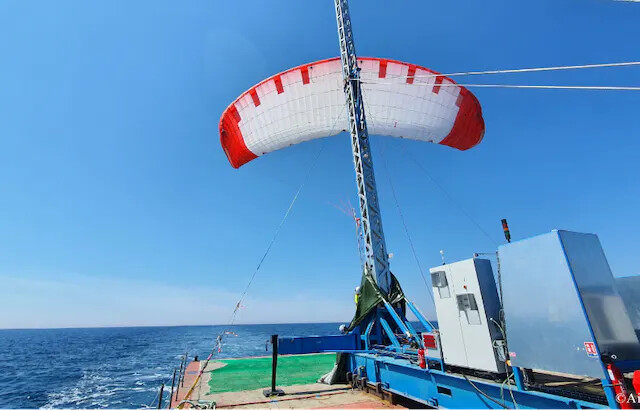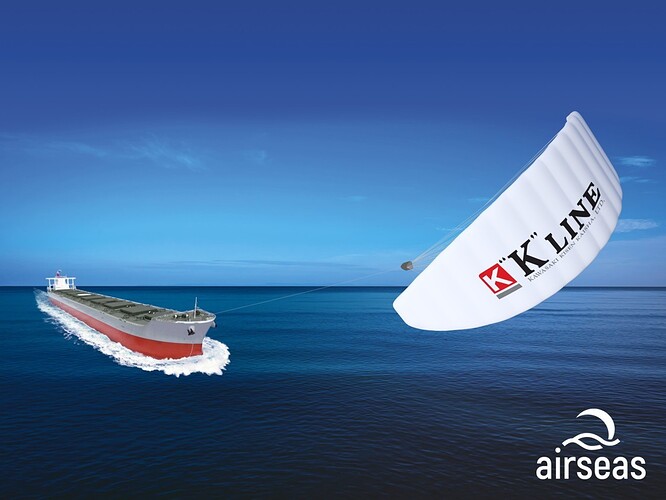
I remember back in the 1980’s, taking a CAD class, my first drawing was a ship being pulled by a parafoil kite. I wondered why nobody else seemed to see the simple solution I saw. Today I am not so convinced. Is this really a new era for shipping? Seems like all we ever see, after years of ship-pulling kites, is vague statements of “we AIM to REDUCE emissions” by a certain percent, chosen to be just significant enough to bother mentioning. Will such savings be attained in reality? Will the kites catch on, really? Or is it possible that we’ll have them around for a while due to legislation passed that favors kites as a visible symbolic statement of “We know we are burning a lot of fuel, but at least we’re trying to do something about it”, until at some point, it becomes a silly tip-of-the-hat, amounting to what is often called “virtue-signalling”, which means coming up with excuses for burning a lot of fuel while condemning the use of fuel for “the little people”, like when all the bigwigs fly their private jets to meetings lamenting people driving to work or using plastic soda straws?
So here we have another prediction of the future. But it has been noted that predicting things is fraught with error, especially when it concerns the future. Why is it always “the first flight” or “first journey”, or first whatever, when this concept has now been around for at least a decade? How much fuel does it really save? Hard for me to say sitting here on dry land, but I am now far less convinced than I was 40 years ago.
On further thinking about kites pulling ships, why is it always just an “assist” rather than “the kite pulling the ship”? I mean, if a kite can exert a pulling force on the ship sufficient to save a certain percentage of fuel, why is the kite not simply made large enough to exert ALL of the force necessary to pull the ship? They never seem to explain that one. If one kite can save 20% of the fuel , then why not use a stack of five (5) kites and save ALL of the fuel? Could it be that the only “safe” position for these ship-pulling-kite companies is a slight decrease in fuel use, because if the effect is slight enough, they can just exaggerate the effect and get some sort of carbon credits or something when maybe the kite is doing next-to-nothing except this “virtue-signalling” we hear about so often? I think the whole thing is getting pretty fishy, if you’ll excuse the very weak pun. We still don’t see any yachts being pulled by kites except that same old symbolic catamaran covered with solar panels, which likely has a nice diesel backup for when nobody’s watching.
Not sure why kites can pull surfers along so well, and not boats, but at this point, it’s getting to be an old idea, with some pretty well-funded companies executing some impressive-sized demo projects, but to me, as with kite-reeling, there must be some reason why it never gets past the “prototype” or “demo” stage. It almost seems that with the number and power capacity of units produced and deployed so far, and the subsequent lack of follow-through, the technologies are in the process of disproving themselves(?)
Similar to hydrogen cars, which any third-grader could do the math on and see what a waste of energy hydrogen-as-fuel is. I just read that Shell has removed hydrogen fueling systems for cars in the UK, due to lack of use, and lack of interest. It is weird how otherwise sensible people and companies fall for the hydrogen story - 1/5 as efficient at 10x the cost - what’s the point?
LINK:
https://www.electrive.com/2022/10/18/shell-quietly-closes-all-hydrogen-filling-stations-in-the-uk/
“Seawing aims to reduce fuel consumption and emissions by an average of 20%.”
As someone whose first CAD drawing way back in the 1980’s was a kite pulling a boat, I yet remain skeptical.
The telltale clue: 20%. It’s as though the promoters can;t get past the “pretend” stage of pulling a boat by a kite. It’s always the same, tired story: 20%, - or maybe 15%, or “trying for” 20%. Really? No ship just being “pulled by a kite” but only ever “assisted”. In other words, without an actual engine, forget it. Withouyt the engine, you can’t fake it, so you NEED the engine to do most of the work, and the kite can hopefully “help a little”.
OK kids - time for your nap - when you wake up we’ll have milk and cookies, then we’ll have a lesson on why we changed the term “global warming” to “climate change”… (hint: so they can blame the snowstorms that were supposed to be extinct on it - whatever “it” now is… ![]()
Why is anyone in Wind Tech surprised power kites are relentlessly industrializing?
50yrs of R&D is paying off for those who have persisted-
Airseas’ Groundbreaking Kite System Installed on Massive Japanese Carrier - autoevolution
KiteShip USA started it all in the 1970s. This is a SkySails-licensed Airbus spin-off-
This could easily turn out to be “greenwashing” where the most intensive users of fossil fuels try to make “statements” indicating their “virtue” insofar as they are “transitioning away from fossil fuels”, like when Chevron says they are “decarbonizing” - Oh yes, we totally hate fossil fuels, even though they are our main product!"
Meanwhile, with the discovery of methane clathrates at the bottoms of our oceans, it looks like hydrocarbon fuels might be 100% sustainable, as long as all the carbon stays on planet Earth!
After 15 years of such “forward-looking statements” never coming true, I’d have to place AWE in general, under the category of a cult, a branch of a larger catastrophe-based, “end-of-world” religion, the tenets of which must never be questioned, with the resulting statements not to be properly scrutinized, lest people stop throwing money at them. Do I see any reason klites can’t pull a ship? No, in fact I thought it was my original idea back in the 1980’s. But now that it’s been tried several times, it seems to not be worth the trouble. Why? Not sure, but this is no longer the first rodeo… ![]()
Hi Doug, indeed, quote from the article on LinkedIn:
Subscribe for more premium engineering stories: LinkedIn
We are now looking at the next 15 years.
AWE - where all accomplishments or true progress remain perpetually “in the future”… ![]()
This topic starts with: “A new era of wind power…”. 15 years is even short for a new era. A new era to come implies something “in the future”.
Hi Pierre:
OK I read the Linked-In article.
A few things jumped out at me.
One was the fact that they use bunker fuel because it is cheap.
As science-type people, we know bunker fuel is the leftover “tar” from fractional distillation that produces the useful gasoline, lubricating oils, and other petroleum products most people are familiar with.
The question that popped into my feeble brain was “OK so what happens to the bunker fuel if ships don’t burn it?” Does it become “toxic waste” that must then be “disposed of”? Doubtful. Industry doesn’t like to waste anything, so it will probably be burned somewhere else, for some other purpose, probably as fuel for something. Net reduction in bunker fuel use? Probably zero. Maybe negative - read on…
The next question is, what about the “harm” being done by NOT burning the high-sulfur bunker fuel, since NOT burning bunker fuel might be causing “global warming” by reducing the reflective sulfur molecules in the air.
The next, somewhat alarming thing I read was the ship must travel SLOWER for the sails to do their job. This is starting to sound familiar - think I heard it before but didn;t quite “get it” then. So if the ship were going at normal speed, the sail (kite) would become ineffective??? The ship would be towing the kite at that point? Hmmm… One more reason against pulling ships with kites? It actually slows them down? But they use less fuel.
Now I remember where I heard this - someone was explaining how they could get the same advantages of the kite, with no kite - just have the ships go slower and they use less fuel. Well, that obviously ignores the entire established economics of running ships - they cost capital and resources to build, and they must pay for themselves by meeting delivery schedules. If not, they lose money, and then more ships need to be built to ship the same amount of cargo, which uses more energy, so in the end you’d be using more energy to build more ships, requiring more crews, so each ship would burn less fuel to deliver less cargo.
The cult-followers are not able to follow such a complicated story, they just want to promote “bumper-sticker” reasoning, to get funded, to waste peoples’ money, time, and resources for what amounts to one more example of “chasing the dragon”. Chasing a dream that ends up using more fuel, not less. But the promoters don’t care. Why? Because it is a public-relations flim-flam, not a real effort to power ships. The fact that no fuel is saved pales in comparison to the real “reason” for the kites. The REAL reason is so corporations that use a LOT of fuel can pretend they are “doing something about it”. This is often called “greenwashing”, even though if we follow the science, there is nothing greeener than burning fossil fuels, since it greens the planet, starting with Africa. Oh well, I’m sure I’ve lost most cult-members by now - logic and religion are like oil and water - both useful but they don’t really mix very well. And nobody cares. ![]()
In this case, the quantity of bunker fuel produced will be reduced.
But since what is called “bunker fuel” is just the leftover waste after distillation, I’m not sure if it could be reduced.
This may be possible when all oil production is reduced.
- vertical cylinders that spin with the wind and create a forward motion – are another type of wind propulsion technology being deployed on cargo ships. In 2018, Finnish company Norsepower installed two of its rotors on the 800-foot-longTimberwolf (formerly Maersk Pelican) tanker. During the first year of operation, fuel savings of 8% were recorded



